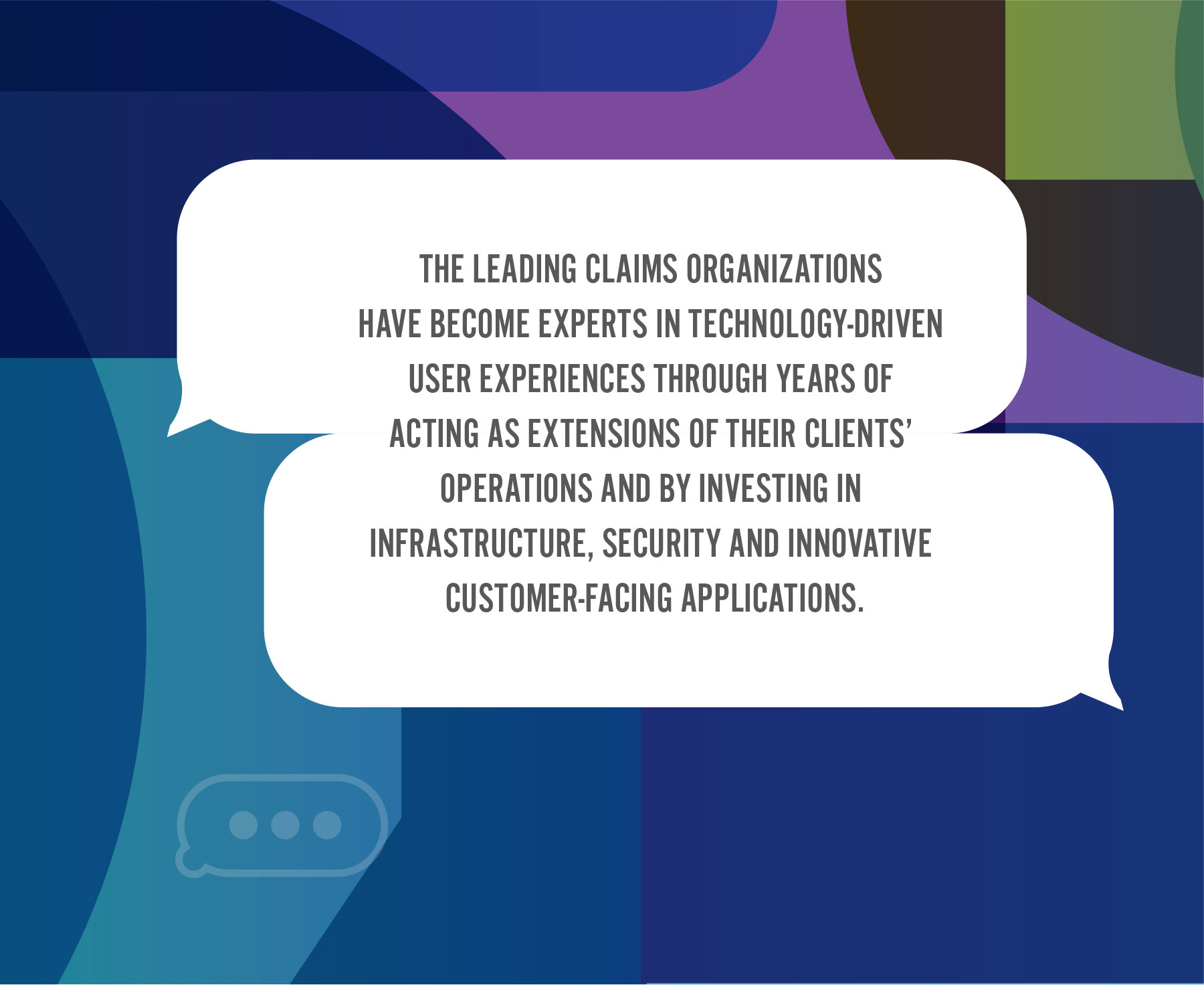CONTRIBUTORS
ERIC MALTERRE
chief client officer – international and CEO – Asia, Sedgwick
SCOTT ROGERS
chief client officer, Sedgwick
Strong relationships and trustworthy support are indispensable today. Organizations operating in this complicated, and sometimes volatile, environment need partners who can supplement their expertise and resources and help them resolve complex issues. When choosing a vendor partner, it’s important to consider their cultural fit with your organization, as well as their ability to grow with you. But perhaps most critical when it comes to a partner is selecting one with the right scope and level of experience to meet your organization’s evolving needs — now and long into the future.
Here, we will draw on our experiences and conversations with customers around the world — employers, retailers, insurance carriers, public sector agencies, corporations and other entities — in exploring some of the reasons why having a claims partner with a broad footprint and range of solutions, as well as a depth of specialized expertise, matters to your organization.
Combating the growing complexity of the risk landscape
Multiple developments over the past few years — a global pandemic and related business interruptions, economic inflation, talent shortages, supply chain issues, civil unrest, geopolitical tensions, technology innovations and vulnerabilities, extreme weather events and more — have highlighted the need for organizations to be prepared for a wide variety of crises. These and other significant risk factors have shown themselves to be fast changing and heavily intertwined, creating complex dependencies that organizations must navigate carefully.
Increasing globalization in today’s economy and workforce means organizations are operating across wider geographies. Claims can occur anywhere at any time, and organizations must have reliable partners with the scalability, connectivity, skills and local presence to quickly support those needs where and when they arise. Having a global claims partner with the right breadth of coverage can offer multiple benefits, including a coordinated approach to managing risk, “boots on the ground” in any location soon after disaster strikes, and sophisticated data integration that can uncover and monitor trends.
Another factor further complicating the risk landscape is the rapidly changing regulatory environment. In the U.S., for example, state-specific laws regarding employee leaves of absence are continually in flux. This makes it very difficult for employers to remain compliant and avoid penalties, accurately grant employees the benefits to which they’re entitled, effectively track workforce absence, and control costs. The confusing patchwork of leave policies across jurisdictions has led many employers to outsource administration of their benefit programs. Partners with national expertise are best equipped to monitor regulatory changes and embed compliance within their processes and technology systems.
Throughout the world, regulations regarding employment, data protection, insurance, building construction and other business arenas continue to evolve. Organizations with a presence in multiple geographies must be able to rely on partners with a deep understanding of how to navigate every local market in which they operate.

Delivering positive user experiences
A confluence of factors has put more emphasis on the user experience in recent years: fierce market competition, consumer expectations of instant gratification, developments in technology and the fact that any brand interaction has the potential to go viral on social media in a matter of moments. With stakes this high, organizations are turning to vendors who can help them transform claims — which most often occur amid negative circumstances — into positive experiences underscored by empathy and caring support. Large-scale partners typically have the resources to attract and retain purpose-driven professionals to deliver such a high level of service, as well as to train them thoroughly and continually on how to meet client and customer demands.
Technology has also assumed a greater role in the delivery of service-related experiences. Today’s consumers have strong individual preferences about how they interact with their employee benefit programs, insurance carriers and other service providers, and they have high standards for technology efficiency, ease of use and immediacy of access. The leading claims organizations have become experts in technology-driven user experiences through years of acting as extensions of their clients’ operations and by investing in infrastructure, security and innovative customer-facing applications. In fact, several of the global carriers with whom Sedgwick partners are currently scaling back their investments in technology tools for their policyholders — opting instead to leverage the strength of our intuitive platforms and applications. Sedgwick has, in many ways, become the go-to expert on technology for the insurance services industry.
While having the right digital tools is a critical piece of the puzzle, it’s no substitute for the invaluable human connection people seek during challenging times. Because claims partners focus on the nuances of the process, they should have a resolute commitment to caring for people when it matters most. They should be instilling in their employees the importance of helping others and resolving complexity, so clients’ employees, customers and policyholders can focus on the things that matter most in the moment. Additionally, their capacity to embrace diversity, equity and inclusion, along with local cultures and nuances, should lead to more personalized care and supportive user experiences.

A range of specialized expertise under one roof
Today’s complicated operating environment tends to reward depth of knowledge and specialized skills over general practitioners. Many organizations look to specialist providers — like claims administrators — to supplement their in-house capabilities and help them service customers and address complex challenges.
The claims partners that are best equipped to meet clients’ wide-ranging and ever-changing needs are those that offer both breadth and depth of expertise.
By way of example, the thousands of talented professionals who comprise Sedgwick’s global loss adjusting team have between them more than 75 subspecialties — from agriculture and automotive to telecommunications and utilities. When large, complicated losses occur, insurers and corporations look to engage partners with in-depth knowledge of not only property loss adjusting and the claims process, but also the particulars of the type of loss.
Large-scale claims organizations can leverage their broad and deep expertise to their clients’ benefit by layering solutions in order to improve outcomes. For instance, here are a few of the ways Sedgwick strives to accomplish this:
- Our wide range of managed care solutions bolsters the ability of our clients and dedicated servicing teams to take good care of employees after injury or illness and facilitate a safe and smooth return to productivity.
- We’ve brought together multiple services in our end-to-end auto liability claims solution: personal injury protection (PIP) medical bill review, appraisals, direct repair, recalls and loss adjusting. Supported by our regional centers of excellence to leverage Sedgwick’s scale and expertise, the solution is designed to drive down indemnity and severity spend.
- Complex property and business losses often require expertise across a variety of disciplines. We offer a suite of specialized solutions that, when warranted, nicely complement loss adjusting, such as building consulting, contents valuation, forensic accounting, fire investigation, forensic engineering, environmental consulting, repair solutions, temporary housing and more.
Beyond the expertise they can offer in specific niches of the claims arena, large-scale partners have the opportunity to distinguish themselves as specialists in particular industry verticals, such as aviation, construction, financial services, food and beverage, healthcare, manufacturing, public entity, retail, transportation, telecommunications and more. By developing thorough knowledge of an industry’s operating models, customer base, objectives, risk profiles, data trends and pain points, claims organizations become more than third party administrators and loss adjusters to their clients; they grow into expert partners who truly understand their needs and whose best practices can make an indelible, enterprise-wide business impact.
A world of resources
By virtue of their size and resources, large-scale partners offer a host of amenities — beyond their claims examiners and loss adjusters — that can make a meaningful difference. Among them are client services professionals dedicated to strengthening the partnership and bringing established best practices to the management of their claims program. Many larger partners have practice leads and other executives who closely follow the latest trends, regulations and industry developments and bring their knowledge to bear on clients’ programs. Another advantage is access to larger pools of talent and resources for managing that talent, to ensure the right professionals are assigned to the clients where they fit best in terms of skillset and cultural alignment.
With regard to technology, a claims partner of greater scope is more likely to have the resources to invest in the systems and platforms needed to administer claims and deliver a strong user experience. They also have the data analysis and reporting tools that enable clients to keep an eye on day-to-day activity, trends and
warning signs.
Events like the COVID-19 pandemic and large-scale natural disasters like the 2022 floods in eastern Australia taught us lessons in preparedness for an all-hands-on-deck approach when catastrophe strikes. Global providers have the advantage of drawing from a world of resources when clients need them most. This kind of scope gives larger partners the ability to say yes when a client or prospect calls with an urgent request. It’s what fuels our capacity to help people wherever and whenever the need arises.
Bringing it all together
These are some of the reasons why we believe it’s advantageous to work with claims partners with a certain level of scope and expertise. When such providers leverage the strength of their collective resources, they prove more agile, operationally efficient and adaptable to changing market conditions and client needs. Connecting the dots through cultures of collaboration, streamlined leadership structures, common processes and shared technology platforms enable large claims organizations to bring the best of all their resources and expertise to their clients.
In our line of work, the devil is truly in the details. Managing claims is a complicated business, and we’re responsible for delivering excellence at every step in the process so things go smoothly. We do that by hiring talented and caring professionals, developing their skills and expertise, and instilling in them that our shared mission and purpose are to fix things and help people. The best way we as a global claims partner can embrace the challenge is by maximizing the vast resources available to us — all the while keeping the customer at the core of everything we do.
